#anti-immigrant sentiment (not mine
Text
At present, it is standard among practically all communities to fête the family as a bastion of relative safety from state persecution and market coercion, and as a space for nurturing subordinated cultural practices, languages, and traditions. But this is not enough of a reason to spare the family. Frustratedly, Hazel Carby stressed the fact (for the benefit of her white sisters) that many racially, economically, and patriarchally oppressed people cleave proudly and fervently to the family. She was right; nevertheless, as Kathi Weeks puts it: “the model of the nuclear family that has served subordinated groups as a fence against the state, society and capital is the very same white, settler, bourgeois, heterosexual, and patriarchal institution that was imposed by the state, society, and capital on the formerly enslaved, indigenous peoples, and waves of immigrants, all of whom continue to be at once in need of its meagre protections and marginalized by its legacies and prescriptions” (emphasis mine). The family is a shield that human beings have taken up, quite rightly, to survive a war. If we cannot countenance ever putting down that shield, perhaps we have forgotten that the war does not have to go on forever.
This is why Paul Gilroy remarked in his 1993 essay “It’s A Family Affair,” “even the best of this discourse of the familialization of politics is still a problem.” Gilroy is grappling with the reality that, in the United Kingdom as in the United States, the state’s constant disrespect of the Black home and transgression of Black households’ boundaries, as well as its disproportionate removal of Black children into the foster-care industry, understandably inspires an urgent anti-racist politics of “familialization” in defense of Black families. Both the British and American netherworlds of supposedly “broken” homes (milieus that are then exoticized, and seen as efflorescing creatively against all odds), have posed an obstinate threat to the legitimacy of the family regime simply by existing, Gilroy suggests. The paradox is that the “broken” remnant sustains the bourgeois regime insofar as it supplies the culture, inspiration, and oftentimes the surrogate care labor that allows the white household to imagine itself as whole. As a dialectician, “I want to have it both ways,” writes Gilroy, closing out his essay. “I want to be able to valorize what we can recover, but also to cite the disastrous consequences that follow when the family supplies the only symbols of political agency we can find in the culture and the only object upon which that agency can be seen to operate. Let us remind ourselves that there are other possibilities.
There are other possibilities! Traces of the desire for them can be found in Toni Cade (later Toni Cade Bambara)’s anthology The Black Woman, published in America in 1970, not long after the publication of the US labor secretariat’s “Moynihan report,” The Negro Family: The Case for National Action. The open season on the Black Matriarch was in full swing. And certainly not all of the anthology’s feminists, in their valiant effort to beat back societal anti-maternal sentiment (matrophobia) and the hatred of Black women specifically (more recently known as “misogynoir”), make the additional step of criticizing familism within their Black communities. But one or two contributors do flatly reject the notion that the family could ever be a part of Black (collective human) liberation. Kay Lindsey, in her piece “The Black Woman as a Woman,” lays out her analysis that: “If all white institutions with the exception of the family were destroyed, the state could also rise again, but Black rather than white.” In other words: the only way to ensure the destruction of the patriarchal state is for the institution of the family to be destroyed. “And I mean destroyed,” echoes the feminist women’s health center representative Pat Parker in 1980, in a speech she delivered at ¡Basta! Women’s Conference on Imperialism and Third World War in Oakland, California. Parker speaks in the name of The Black Women’s Revolutionary Council, among other organizations, and her wide- ranging statement (which addresses imperialism, the Klan, and movement- building) purposively ends with the family: “As long as women are bound by the nuclear family structure we cannot effectively move toward revolution. And if women don’t move, it will not happen.” The left, along with women especially of the upper and middle classes, “must give up ... undying loyalty to the nuclear family,” Parker charges. It is “the basic unit of capitalism and in order for us to move to revolution it has to be destroyed.”
Forty years later, the British writer Lola Olufemi is among those reminding us that there are other possibilities: “abolishing the family...” she tweets, “that’s light work. You’re crying over whether or not Engels said it when it’s been focal to black studies/black feminism for decades.” For Olufemi as for Parker and Lindsey, abolishing marriage, private property, white supremacy, and capitalism are projects that cannot be disentangled from one another. She is no lone voice, either. Annie Olaloku-Teriba, a British scholar of “Blackness” in theory and history, is another contemporary exponent of the rich Black family-abolitionist tradition Olufemi names. In 2021, Olaloku-Teriba surprised and unsettled some of her followers by publishing a thread animated by a commitment to the overthrow of “familial relations” as a key goal of her antipatriarchal socialism. These posts point to the striking absence of the child from contemporary theorizations of patriarchal domesticity, and criticize radicals’ reluctance to call mothers who “violently discipline [Black] boys into masculinity” patriarchal. “The adult/child relation is as central to patriarchy as ‘man’/‘woman,’” Olaloku-Teriba affirms: “The domination of the boy by the woman is a very routine and potent expression of patriarchal power.” These observations reopen horizons. What would it mean for Black caregivers (of all genders) not to fear the absence of family in the lives of Black children? What would it mean not to need the Black family?
Sophie Lewis in “Abolish Which Family?” from Abolish the Family: A Manifesto for Care and Liberation, 2022.
178 notes
·
View notes
Note
Wait wait wait, people said Jewish people should go back to Poland?
Wasn’t there a certain camp that basically the only one that you think of when talking about the Holocaust due to the arm numbering?
Oh right
AUSCHWITZ, YOU WANT JEWISH PEOPLE GO BACK TO THE CENTERPIECE OF THE FUCKING HOLOCAUST?!
In 6th grade, I read The Devil's Arithmetic, and before the girl went back to the past. One of Jewish elders said it was miracle one of family members was born in America
Yes despite our rampant antisemitism (though now it cause by pro Palestine people now) several Jewish people would prefer living in America vs in the old world
AAAAAH, A FUCKING 2012 UBISOFT GAME SHOULD’NT GIVE ME A BETTER UNDERSTANDING OF COLONIAL AND 20 CENTURY IMMIGRATION TO THE NEW WORLD THAN COLLEGES
Ugh, but anyways, the game pointed out a lot of persecuted people in the old world were FLEEING to the Americas for a better life and the hell it was
Theory of mine, I think the creation of modern Israel as part of the aftermath of the Holocaust is left out in our education system not to piss off arab nations who fund it.
(Probably Arabs love leaving out that a lot of Nazis went to their countries to escape persecution as well)
For about nine years this fall, I was called a Nazi apologist for preferring an evil space wizard.
Yet as I type, I for some reason understand the plight of descendants of Holocaust survivors more despite working at a Amazon warehouse and have a HS diploma only
What the fuck is going on?
Wait wait wait, people said Jewish people should go back to Poland?
AUSCHWITZ, YOU WANT JEWISH PEOPLE GO BACK TO THE CENTERPIECE OF THE FUCKING HOLOCAUST?!
Before WWII there were 3.3 million Jews living in Poland, after the dust settled there was 380,000. Nearly 90% of the Jews in Poland died as a result of WWII, and some of them weren't welcome back home after they'd been freed from the camps, all kinds of reasons for that but it's not like Poland was terribly welcoming.
Communism thing to deal with too, behind the iron curtain wasn't super safe for Jewish folks either. Double bad given the Antisemitism baked directly into communism.
In 6th grade, I read The Devil's Arithmetic, and before the girl went back to the past. One of Jewish elders said it was miracle one of family members was born in America
Yes despite our rampant antisemitism (though now it cause by pro Palestine people now) several Jewish people would prefer living in America vs in the old world
We've done better here in the US than lots of places on that, or I'd thought we had till all this started up, did get a preview of what was in store a few years back after Israel kicked some squatters out of a home that had been purchased while the place was a province of the Ottoman Empire.
AAAAAH, A FUCKING 2012 UBISOFT GAME SHOULD’NT GIVE ME A BETTER UNDERSTANDING OF COLONIAL AND 20 CENTURY IMMIGRATION TO THE NEW WORLD THAN COLLEGES
They have to break down complicated things into simple easy to understand bits of knowledge, it's handy and a good jumping off point since it's not overly complicated usually.
Ugh, but anyways, the game pointed out a lot of persecuted people in the old world were FLEEING to the Americas for a better life and the hell it was
That was one of the reasons several of the colonies and settlements happened starting at the begining
Theory of mine, I think the creation of modern Israel as part of the aftermath of the Holocaust is left out in our education system not to piss off arab nations who fund it.
there wasn't a lot about it when I was in school and the anti Israel sentiment hadn't gotten anywhere near where it is now then, but there might be something to that.
Also only so much time to teach, so that gets in the way too.
For about nine years this fall, I was called a Nazi apologist for preferring an evil space wizard.
Yet as I type, I for some reason understand the plight of descendants of Holocaust survivors more despite working at a Amazon warehouse and have a HS diploma only
We did the whole thing with Louis Armstrong and the family that kinda took him in and taught him a bunch of different Jewish Lithuanian songs, made enough of a impact on him that he wore a Star of David on a necklace his whole life.
'Met these nice white people and it confused me that they were treated the same way black people were by their fellow white people'
You'd think there would be some kind of solidarity there from the two groups, and there was for a good long while here.
What the fuck is going on?
That would be this for lots of people

Chuggin that flavor aid
15 notes
·
View notes
Text
The Bee Keeper's Assistant
I have been volunteered to talk to children about honey bees.
I never chose to be a bee keeper, once a source of childhood pride, now something I would rather put behind me. There just always needed to be an extra pair of hands and they just always happened to be mine.
I want to tell these children "this is a honey bee, she is wonderful and she is beautiful, but she is not supposed to be here. Humans brought her here from far away, across the ocean, because we wanted her honey and wax. That was not kind of us."
"Sometimes animals or plants come from somewhere else and they work together with the plants and animals that live here and that is nice. Sometimes animals or plants come from somewhere else and they hurt the plants and animals that live here and that is not nice. People will bring plants or animals from somewhere else and put them in a new place and that is not good of us, for the new animals or the old animals."
"You see, there are lots of bees already living here, wasps and flies and moths and bats and other animals too, that all pollinate flowers and help them grow, and honey bees hurt those animals. It's not the honey bees' fault, they just want to make honey like they did back home, but humans didn't think about the other animals and how the honey bees would hurt them before we brought honey bees here."
"So, if you know someone who wants to help bees or the planet in general, tell them to help the bees that live here. There are already lots of people who have honey bees, we do not need more. We need to help the bees and other animals that lived here before the honey bee to go back to their homes."
Some people call anti-invasive species sentiment anti-immigrant, but I consider it anti-colonial.
I am a honey bee, and like she I have been here a long time, my mother's mother's mother was born on this soil, but I do not belong. Just living my life hurts the lives of others because I have not learned how to live in harmony. I am not naturalized to this place, a part of the existing web, but rather impose my will onto it. Like the honey bee, I do not do this out of cruelty, but because it is what I know.
Unlike she, I can change, we all can. I think that is a beautiful part of being human.
It's hard looking around at bare sod lawns and ornamental landscaping and thinking "none of this is what it was, what it is supposed to be".
My father wondered why the frogs stopped singing in the summer, but when I mention run off from the new neighborhood into the creek where they spawn the conversation ends. My mother wondered why the lightning bugs stopped shining at night, but when I talk about the raking of leaves and mowing of lawns which deprives them of food and habit the conversation ends.
I go to a forested park and see how young all the trees are and how they all seem to be the same, and I know this is not natural.
I no longer want to be a bee keeper's assistant, invasive and destructive. I want to be the lake that becomes a bog that becomes a field that becomes a scrub that becomes a wood that becomes a forest. May I grow wiser and deeper and more complex with time so that we may all live and thrive together.
15 notes
·
View notes
Text



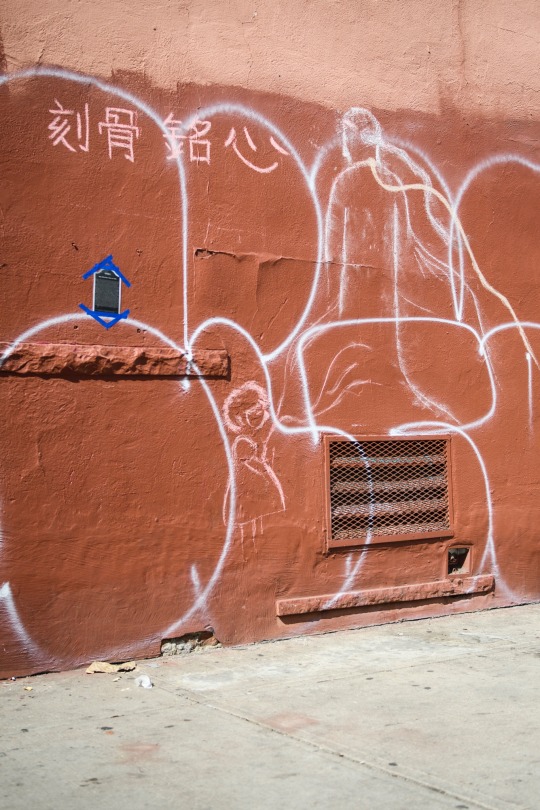
刻骨銘心:to be engraved on one’s bones and heart
To remember with eternal gratitude
Today I made a chalk mural dedicated to the spirit of Denver’s Chinatown. I only just recently learned about the horrific history of Denver’s Chinese population, but I’ve felt it’s absence deeply throughout my life, especially my childhood. I wanted to connect to the spirits of those who once lived here, long forgotten by residents. It’s done in chalk, so the next time it rains it will wash away as did the history of the Denver Chinese. However, I’ve included a “plaque” to replace the since-removed, historically inaccurate plaque. I don’t plan to remove it, so it will remain until someone else removes it or it falls away.
Alt text for plaque: Hop Alley/Race Riot of 1880
During the 1860's, the first Chinese immigrants settled in Colorado, drawn here by the completion of the transcontinental railroad as well as by other demands for cheap immigrant labor. Most immigrants traveled to America to attempt to earn enough money to send to their friends and families before returning to China. Living amidst persecution, poverty and wretched living conditions, they worked mostly in laundries, as house servants and in the mines. The Chinese immigrants were able to distinguish themselves as clever and hard workers across the country. The Chinese occupied neighborhood was bounded roughly by Blake and Market, 19th and 22nd Streets, and contained about 500 people. Despite being full of rich culture and history as well as hard workers, Chinatown was only known for its opium dens where one could "hit the pipe" or "suck the bamboo". For this reason it was given the nickname "Hop Alley". Opium was weaponized by white colonizers in the early 1800's in order to cripple and subdue a thriving empire that threatened the dominance that the colonizers held over the surrounding areas. As anti-Chinese sentiments and general xenophobia rose, the Chinese struggled to maintain their peace. On October 31, 1880, in John Asmussen's Saloon, located on the 1600 block of Wazee, an argument broke out between two men playing pool and some intoxicated white people. When the Chinese men attempted to de-escalate and slip out the back door, they were attacked and beaten, beginning Denver's first recorded race riot. About 3,000 people congregated quickly in the area, shouting "Stamp out the yellow plague!" Absolute destruction of the Chinese neighborhood ensued. Though many Chinese people surely showed remarkable courage, only White saviorism was recorded from this event. Dozens of Chinese people were injured, and one man, Look Young, was murdered from being beaten to death and then dragged through the streets by his neck with a rope. Despite the murder and violence witnessed by thousands, the aggressors were never punished for their actions. It's reported that Chinese business owners suffered over $1,000,000 current dollars in losses. The Chinese government reached out in an attempt to recover these losses, a courtesy the Chinese had extended to American missionaries in similar situations in China. However, none of the Chinese business owners ever received compensation. To this day, the only reparations made by Denver were some gold medallions given to descendants of the Denver Chinese population. This story has vanished into near complete oblivion in Colorado memory which makes it all the more important that you are reading this. Thank you.
12 notes
·
View notes
Note
hello i was wondering if you had any information or thoughts about unification for DR & Haiti / “unified kiskeya”? I’ve seen this idea(?maybe it was hypothetical?) in relation to Cyprus and to a lesser extent Palestine. Though that of course confused me as these are all 3 regions with different legacies from imperialism, but maybe i could see some connecting lines.
Some context:
There was a time when Haiti n Dominican Republic were unified for like. 22 years. In 1820s-1840s. But you'll likely find it called "Haitian occupation"
N then D.R. revolted and seperated from Haiti ("dia de independencia dominicana" - february 27, 1844),
D.R. made anti-black anti-Haitian propaganda,
and D.R. was at risk of re-conquested n re-enslaved by Spain, because of seperating from Haiti, so Haiti had to still help them right afterward too...
Both Haiti and Dominican Republic were colonized by France and Spain respectively,
but Dominican Republic is more "proud" about being colonized n Spanish "heritage"... despite all the death, suffering, and such.
A lot of Haiti's fertile land was intentionally destroyed by the French. France put Haiti in enormous debt + pushed Haiti to be excluded from other countries, for even daring to liberate themselves from enslavement.
while Dominican Republic retained the fertility of soil and benefit from Haitian labor while discriminating against Haitians n those of Haitian descent (Haitian-Dominican).
The anti-Haitian sentiment was at its peak when dictator Trujillo was in charge, resulting in several anti-Haitian massacres like the Parsley massacre in october 1937 - that killed Haitian, dark-skinned black people, anyone who pronounced "perejil" in a Haitian way. With Trujillo wanting Haitian n dark skinned black people to be wiped out and whitened from population.
Currently, there often tightening of Haitian-Dominican border. Still people hiring Haitians for domestic work (maids, caretakers, food distribute) n hard labor (construction, waste), but paying them much lower, while make immigration difficult. N of course police n medical discrimination. Xenophobia.
Am Dominican of supposedly Haitian descent on biological father but was never claimed on birth certificate anyways (born out of wedlock), but am less discriminated against than Haitian-Dominicans with documented heritage.
But at same time - Haiti is negatively affect by, occupied by, wrecked by, bigger countries n organizations even more "effectively". Haiti not have stable government n infrastructure, they have no chance to. Though Haitians are resilient people.
United States, U.N., whatever other countries want to. Will mess with n extract value from Haiti (like charity scams ala Bush Foundation, like mining, like other country military popping into Haiti, n much more)
So at moment, unification of quiskeya n Hayti not the priority on activist mind quite as much as getting those influence out n end exploitation.
A proper Unified Hayti / Quiskeya would be nice if it worked out tho.
#anonymous#ask post#o post#response#antiblack racism#xenophobia#haiti#sij#colonialism#dominican republic
4 notes
·
View notes
Text

watching the pbs documentary on this guy and it just glosses over the racism and his role in anti-chinese-immigrant sentiment in the 1890s and also glosses over how the only way he succeeded was by perpetually borrowing from his father's gold mine fortune
5 notes
·
View notes
Text
Indian-British academic opens up about being deported for her anti-India stance
The Indian-origin British academic, Nitasha Kaul responds to the claims behind her deportation from India after she landed at Bengaluru's Kempegowda International Airport last weekend. There were many assumed reasons behind her deportation including "married to a Pakistani... a pawn of China... a puppet (of the) West..."
As per a government source, Kaul was deported because of her anti-India stance and pro-separatist thinking. However, Kaul in a statement said, "I am authoritarian fear... a thinking woman".
In a post on X, Kaul wrote, "Re: all the lies, I am not married to a Pakistani, not a Muslim convert, not a pawn of China, not a puppet of (the) West, not a commie (Communist), not a jihadi, not a Pak sympathizer, not a terrorist supporter, not anti-India, and not part of a gang."
"My experience was harrowing... but the humiliation is not mine. It is that of a ridiculous, insecure regime. What I have termed 'moral wound of colonialism' in my work is very much on display."
"Selective resurrections of past macro histories are used to manipulate present sentiment," she said.
"I urge you to think beyond walls of hate against those different from you... and to read and understand what I say and think, before rushing to condemn. It is hard but it is possible."
Nitasha is a Professor of Politics, International Relations, and Critical Interdisciplinary Studies at the University of Westminster in London. In her words, she is a “Kashmiri Novelist”.
Nitasha on Sunday took to Twitter and posted a detailed post wherein she said that she has been "denied entry to India for speaking on democratic and constitutional values".
"I was invited to a conference... by the Government of Karnataka (a Congress-ruled state) but the center refused me entry. All my documents (UK passport and Overseas Citizen of India card) were valid..."
"I was given no reason by immigration except, 'We cannot do anything, orders from Delhi'."
For more national news India in Hindi, subscribe to our newsletter.
#werindia#leading india news source#top news stories#top news headlines#top news of the day#world news#international news
0 notes
Text
Five Interesting Salvadoran Non-fiction Books
"Solito : A Memoir" by Javier Zamora
Javier Zamora’s adventure is a three-thousand-mile journey from his small town in El Salvador, through Guatemala and Mexico, and across the U.S. border. He will leave behind his beloved aunt and grandparents to reunite with a mother who left four years ago and a father he barely remembers. Traveling alone amid a group of strangers and a “coyote” hired to lead them to safety, Javier expects his trip to last two short weeks. - (Amazon.com)
2. "The Salvador Option: The United States in El Salvador, 1977-1992" by Russell Crandall
El Salvador's civil war between the Salvadoran government and Marxist guerrillas erupted into full force in early 1981 and endured for eleven bloody years. Unwilling to tolerate an advance of Soviet and Cuban-backed communism in its geopolitical backyard, the US provided over six billion dollars in military and economic aid to the Salvadoran government. El Salvador was a deeply controversial issue in American society and divided Congress and the public into left and right. Relying on thousands of archival documents as well as interviews with participants on both sides of the war, The Salvador Option offers a thorough and fair-minded interpretation of the available evidence. If success is defined narrowly, there is little question that the Salvador Option achieved its Cold War strategic objectives of checking communism. Much more difficult, however, is to determine what human price this 'success' entailed - a toll suffered almost entirely by Salvadorans in this brutal civil war. - (barnesandnoble.com)
3. "Defender el agual" by Robin Broad and John Cavanagh
If you had to choose, would you trade water for rivers of gold? More than 20 years ago, mining corporations posed this dilemma to the people of El Salvador, under the promise that the precious metals industry would be synonymous with progress. But "green mining" only brought with it poisoned basins and springs, as well as the persecution of those who stood up against the dispossession and destruction. Robin Broad and John Cavanagh recount here the improbable triumph of those in El Salvador who decided to defend water and formed a popular resistance movement that confronted death and corruption through political ingenuity and the creativity of community organizations. This story, in which narrative journalism is mixed with legal and historical chronicle, takes us from the beautiful landscapes of Cabañas and Chalatenango to the cold corridors of the World Bank in Washington, where the fate of the small town's water resources was settled. . Central American nation. Rather than an isolated success story, the story Defending Water tells gives many reasons to enhance the optimism and conviction of those who will never believe that money is worth more than water or, in other words, more than life. - (barnesandnoble.com)
4. "State of War" by William Wheeler
One of President Donald Trump’s favorite rhetorical motifs is stoking fear that members of the MS-13 gang from El Salvador intend to cross the U.S. border in force and wreak havoc on American society. It’s an inaccurate scenario, and in State of War, foreign correspondent William Wheeler tells the real story: In the 1980s, the U.S. supported the repressive Salvadoran government in a brutal civil war, and many Salvadoran families fled to America—especially Los Angeles, where teenagers in poor neighborhoods founded MS-13. A decade later, the U.S. responded to rising anti-immigrant sentiment by deporting many Salvadorans back home. Ever since, El Salvador has been one of the most violent countries in the world. (barnesandnoble.com)
5. "Made in El Salvador" by Roberto Valencia
The chronicle is the novel of reality, Gabriel García Márquez once said. With that maxim as its guiding principle, Made in El Salvador compiles sixteen of the best chronicles and profiles that journalist Roberto Valencia has signed over a dozen years. A muscular book, full of surprising stories and endearing characters, with blue and white as the flag. Salvadoran export journalism. -(Amazon.com)
1 note
·
View note
Text
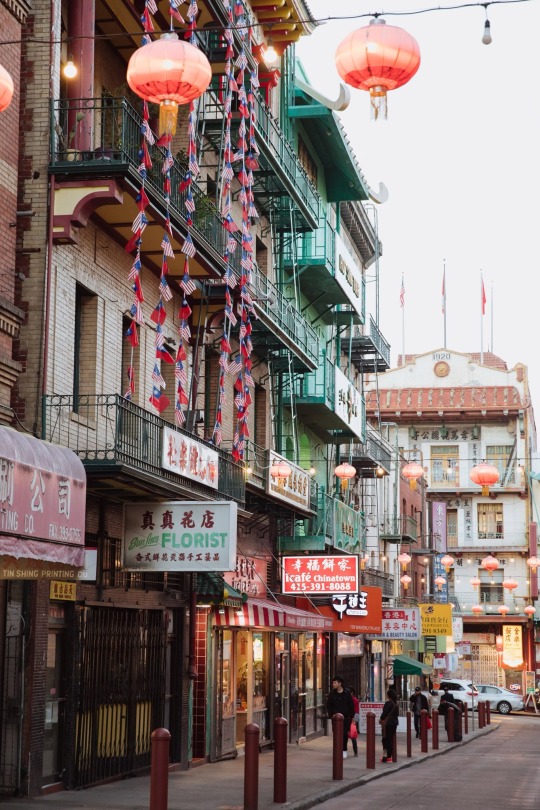
In San Francisco’s Chinatown, the commerical thoroughfare Waverly Place includes pagoda-like storefronts and strings of lanterns. Much of the neighborhood’s “exotic” vibe was engineered by 20th-century merchants hoping to lure tourists to the area.
Why Does The U.S. Have So Many Chinatowns?
Rooted in both racism and marketing, historic immigrant enclaves grapple with a crippling pandemic, rising rents, and uncertain futures.
— By Rachel Ng | Photographs By Andria Lo | Published September 14, 2020
Behind an ornate archway with a tiled, curved roof in Los Angeles’s Chinatown, a solemn golden statue of Chinese revolutionary leader Dr. Sun Yat-Sen sits alone. Although it’s a sunny August afternoon, most of the souvenir stores and art galleries surrounding him in the usually busy Central Plaza marketplace are closed due to the coronavirus pandemic, doors locked shut behind heavy metal gates. The craggy Wishing Well at the center of the shopping zone is bone dry.
The eerie silence breaks as a figure—spotting me—emerges from underneath an unlit “Phoenix Imports” neon sign. “Come on in!”

Diners eat at New Lun Ting Cafe in San Francisco’s Chinatown in 2016.
Born and raised in Chinatown, Phoenix Imports owner Glenn SooHoo has witnessed the growth, decline, and revitalization of his neighborhood over the past 50 years. Since as early as Lunar New Year in January, L.A.’s Chinatown—and other such enclaves across North America—has been in crisis, buffeted by the twin traumas of xenophobia and a public-health crisis.
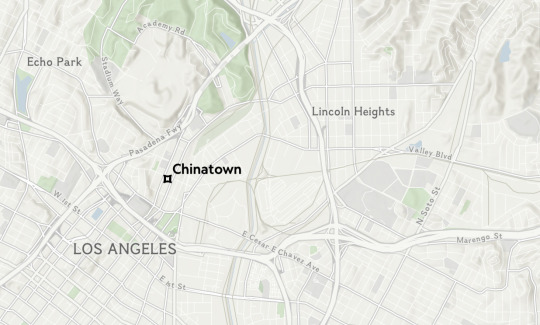
“The virus is hampering business and the tourist industry,” says SooHoo. “At New Year’s, we had our 121st Golden Dragon Parade celebration, and only like 10 percent of the people showed up. The virus didn’t have anything to do with Chinatown, but it being associated as an Asian thing by the president, people just got that phobia about it.”
As historic Chinatowns struggle during the pandemic, it’s worth looking at why residents—and visitors—flocked to them in the first place.
A Land of Opportunity—and Gold
Chinatowns have been in the U.S. for more than 170 years. The first one, in San Francisco, served as an unofficial port of entry for Chinese immigrants escaping economic and political chaos in the mid-1800s. Men sought their fortunes in the California Gold Rush, and when mining waned, they found work as farmhands, domestic helpers, and in the 1860s, as workers for the Transcontinental Railroad. These men needed sleeping quarters, clean clothes, and hot meals after long days of grueling labor; this led to a proliferation of housing, laundry services, and restaurants in burgeoning, Chinese-centric neighborhoods.
As the immigrants fanned out around the country seeking more work, Chinatowns mushroomed all over the United States. At one time, there were more than 50 of them.


Left: A chef prepares eggs boiled in tea and spices at Hon’s Wun-Tun House in San Francisco’s Chinatown. Right: Asian immigrants settled in Oakland, California’s Chinatown during the 19th- and early 20th-centuries. The neighborhood still hosts multiple Chinese-run businesses, including one of the oldest fortune-cookie factories in the U.S.

San Francisco’s Chinatown is the oldest one in the U.S., and the largest outside of Asia.
But these Chinatowns were also borne out of growing racial tension and discrimination in housing and employment. After the abolition of slavery, Chinese immigrants provided a cheap source of labor, leading to resentment from the white working class, especially during the Long Depression from 1879 to 1896.
Beginning in 1882, the Chinese Exclusion Acts severely limited immigration for more than 60 years. Anti-Chinese sentiment resulted in street brawls, race riots, and even lynching and massacres. During that time, many Chinatowns were destroyed by fire or natural disasters or abandoned by people fleeing the violence.
Immigrant Cities Rising From the Ashes
While the earliest Chinatowns comprised modest wooden and brick buildings, the Asian motifs—pagodas, tiled roofs, bamboo-shaped fonts, and dragon imagery—we see today came about as a way to promote tourism. When the original San Francisco Chinatown was destroyed by the 1906 earthquake and the devastating fire that followed, a group of wealthy Chinese merchants saw an opportunity to combat anti-Chinese sentiment by giving their neighborhood a flashy makeover.
Until then, San Francisco’s Chinatown was thought of as a seedy, crime-ridden ghetto, rife with opium dens, gambling, and prostitution. The Chinese merchants hired Scottish-American architect T. Paterson Ross and engineer A.W. Burgren to design a new Chinatown, incorporating religious iconography and architectural elements of the 10th-13th century Song dynasty.
The new neighborhood was a fantasy vision of China, a country neither man had ever visited. A prominent Chinese-American businessman, Look Tin Eli, spearheaded the project as a new city with “veritable fairy palaces filled with the choicest treasures of the Orient.” The strategy worked: San Francisco’s Chinatown was reborn as an “exotic” destination for Western tourists.
Other Chinatowns followed suit, adopting similar aesthetics. After Los Angeles’ original Chinatown was torn down in 1933 to make way for a new Union Station, Chinese community leaders organized efforts to rebuild Chinatown a few miles away. Prolific L.A. architects Erle Webster and Adrian Wilson modeled the open-air Central Plaza in the new Chinatown after the Forbidden City in Beijing, with restaurants, souvenir shops, grocery stores, bakeries, and nightclubs featuring musical performances.
But some Chinatowns took a different tack. Instead of projecting a family-friendly atmosphere, Chinatowns in Chicago and New York City promoted a kind of “slum” tourism, where white tourists were invited to revel in the sights, sounds, and smells of poor, ethnic neighborhoods. Visitors dined at chop suey restaurants, peeked into opium dens, and maybe witnessed a tong (Chinese secret society) gang fight in the alley.
From Bustle to Bust and Back
Chinatowns’ fortunes rose and fell over the ensuing decades. In 1943, President Franklin Delano Roosevelt repealed the Chinese Exclusion Act and immigration opened up again. In 1965, the Hart-Celler Act removed quotas based on national origins, which led to an explosion of newcomers from China, Taiwan, and Southeast Asian countries like Vietnam and Cambodia. Chinatowns, once again, became the first stop for many immigrants.
Peter Ng, CEO of Chinatown Service Center (CSC), moved to L.A. from Hong Kong in the 1970s. “When I first got here, my parents and I lived inside Chinatown,” he says. “Everyone was conducting business inside Chinatown. There were only a couple of authentic Chinese restaurants back then, so everyone came here. It was really a thriving time.” CSC was founded in 1972 to provide health, housing, and advocacy to the growing community.

Kwan Sau Ling, owner of the Lucky Creation Vegetarian restaurant, is pictured in her storefront in San Francisco’s Chinatown in 2016.
The ’60s also marked turbulent times in American history. Washington D.C.’s Chinatown was devasted when Chinese-owned stores were looted and buildings were burned down during the weeklong 1968 riots triggered by the assassination of Martin Luther King, Jr.
Civil unrest and urban decay, along with the search for more housing and job opportunities, prompted immigrants to move away from Chinatowns in D.C. and other cities, giving rise to new satellite Asian communities in places like L.A.’s San Gabriel Valley and New York’s Flushing, Queens. “The Chinese diaspora is cast so far and wide even within large metros that a single hub for Chinese people is no longer practical or desirable,” says journalist Eddie Lin, who grew up in L.A.’s Chinatown in the ’70s.
But before the pandemic, downtown living in many cities had gained popularity and commercial developers had started paying attention to once-neglected Chinatown real estate. Luxury apartments and trendy restaurants took over rent-controlled buildings and mom-and-pop stores. As a result, gentrified Chinatowns in cities like D.C. and San Jose, California, were reduced to shadows of their formerly vibrant selves, with only a handful of Chinese restaurants and arched gateways left standing.
With the Pandemic, Xenophobia and Hope
Enter President Donald Trump and the coronavirus pandemic. “Unfortunately, Trump’s rhetoric around the virus and beyond has empowered even more horrific and racist acts since COVID,” says Hoi Leung, curator of the Chinese Culture Center (CCC) of San Francisco. California has tallied at least 800 hate crimes against Asian Americans and Pacific Islanders since the pandemic began.
Alarmed by anti-Asian sentiment and the downturn in business, many Chinese Americans are fighting back. This year, CCC partnered with artist Christine Wong Yap for the Art, Culture, and Belonging in Chinatown project, for which people were asked to submit their personal recollections of San Francisco’s Chinatown. Through intentional art and educational programming, CCC hopes visitors and residents view the neighborhood like a museum, “where it becomes an interactive site to deepen their understanding and sense of belonging through engaging with stories, people, and history,” Leung says, cautioning that without care and activism, Chinatowns will eventually disappear.


Left: A Buddha figurine sits inside Hon’s Wun-Tun House in San Francisco’s Chinatown. Right: Open-air produce stands line many blocks in San Francisco’s Chinatown.
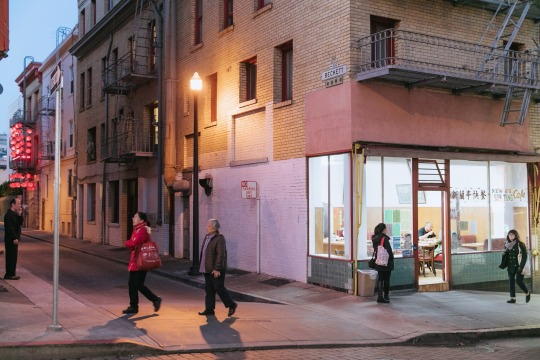
Pedestrians stroll near New Lun Ting Cafe in San Francisco’s Chinatown.
For millennials Victoria Lee and Jennifer Tam, Manhattan’s Chinatown has always held a special place in their hearts. Growing up, Lee spent weekends with her grandmother who lived in Chinatown, while Tam moved to Chinatown a decade ago from Houston, Texas.
After seeing the economic impact COVID had on the neighborhood, the two friends started Welcome to Chinatown, a nonprofit supporting the area’s small businesses with additional resources and revenue streams. “The business impact happened much earlier in Chinatown than in the rest of New York City, due to the rise of xenophobia,” Tam says. “We’re here to help say, ‘Chinatown will always be open for business.’”
Tam and Lee spotlight various businesses on their Instagram page, raise funds to feed the senior community, and partner with local artists to create merchandise like tote bags and mugs. “Welcome to Chinatown is a love letter to Chinatown, a way to give back to a community that has given so much to us,” Tam says. To Tam and Lee, the neighborhood still embodies much of the Chinese-American experience. “It’s important to us that we preserve the narratives and stories that have been built here,” Tam says.
Hard Work and Resilience
In L.A., sun-bleached red lanterns line the green awning of a brick building. Next door, the concrete parking lot has been converted into an outdoor dining space with potted plants, umbrellas, and string lights. Hop Woo was one of a handful of restaurants that remained open during the pandemic. “We’ve never closed,” says chef-owner Lupe Liang. “During the stay-at-home order, we changed to takeout. And now, we have a beautiful space for outdoor dining.”
When Liang and his wife, Judy Cen, opened Hop Woo in L.A.’s Chinatown in 1993, they started with just eight tables. Hop Woo grew to be a thriving business with more than 150 tables, serving garlicky lobster noodles and barbecued meats to a diverse crowd of tourists and locals. “We’ve been in Chinatown for 27 years and we’ve always been busy,” Cen says, “except for this year.”
A few blocks north of Hop Woo at Phoenix Imports, SooHoo is working to ensure his shop’s future. SooHoo’s grandfather, She Wing SooHoo, launched a gift shop called Chew Yuen Company in 1938, one of the first businesses in Central Plaza. When She Wing retired, Glenn’s father Walter took over the family business, opening a storefront next door and renaming it Phoenix Imports.
“We’ve been here for 80 years,” he says. “We’ve been through everything, good and bad, and whatever it is, we’re still going to be here. I’m not here to make money, I just want to keep this Chinatown alive for the next generation.”
0 notes
Text
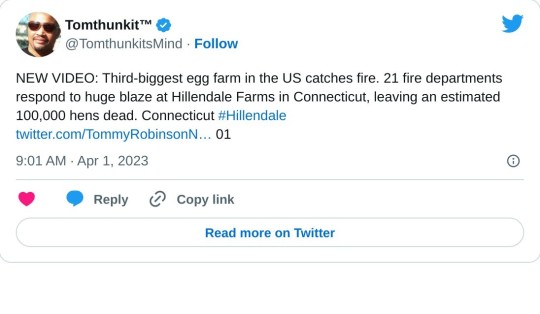
youtube
yet they say the impact from the fire was not predicted to raise prices, and we can all see that the egg industry is raking in record profits this year. some are reporting more than 750% increase in profits. This is gouging which is why I wonder why the egg industry is doing this in america.
heres something we bet you never realized ?
Since Emancipation, agriculture has moved its focus from one labor source to another in response to shifting currents of populism, nativism and racism. All three benefit from the exploitation of minority populations, and all three justify policies of exploitation in economic terms.
Arizona prisons partners with one of the countries largest egg farms?
youtube
these folks not only make egg products, but only cost the state $3.00 per hour in labor. America is the shithole of ethics
read this,
Farmers turn to prisons to fill labor needs
With immigration numbers low, the agriculture industry looks to another form of disenfranchised workers.
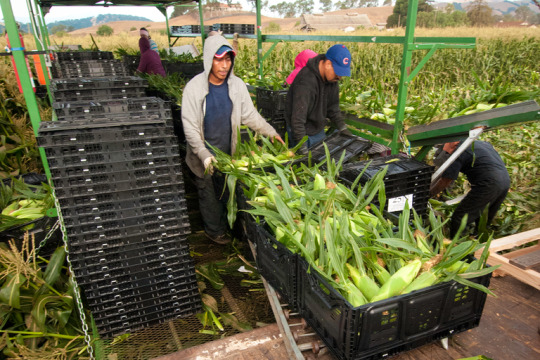
American agriculture often depends on migrant workers, like the one pictured here harvesting corn in Gilroy, California. But the anti-immigration policies of the Trump administration have farmers turning to prisoners to harvest labor-intensive crops.
Prison inmates are picking fruits and vegetables at a rate not seen since Jim Crow.
Convict leasing for agriculture – a system that allows states to sell prison labor to private farms – became infamous in the late 1800s for the brutal conditions it imposed on captive, mostly black workers.
Federal and state laws prohibited convict leasing for most of the 20th century, but the once-notorious practice is making a comeback.
Under lucrative arrangements, states are increasingly leasing prisoners to private corporations to harvest food for American consumers.
Why now?
The U.S. food system relies on cheap labor. Today, median income for farm workers is $10.66 an hour, with 33% of farm-worker households living below the poverty line.
Historically, agriculture has suppressed wages – and eschewed worker protections – by hiring from vulnerable groups, notably, undocumented migrants. By some estimates, 70% of agriculture’s 1.2 million workers are undocumented.
As current anti-immigrant policies diminish the supply of migrant workers (both documented and undocumented), farmers are not able to find the labor they need. So, in states such as Arizona, Idaho and Washington that grow labor-intensive crops like onions, apples and tomatoes, prison systems have responded by leasing convicts to growers desperate for workers.
The racist roots of convict leasing
Since Reconstruction, states have used prisoners to solve labor supply problems in industries such as road and rail construction, mining and agriculture. But convict leasing has also been a powerful weapon of white supremacy, and now, anti-immigrant sentiment.
After Emancipation, southern economies faced a crisis: how to maintain a racial caste system and a supply of surplus labor now that blacks were free.
Southern states passed vagrancy laws, Black Codes, and other legislation to selectively incarcerate freed slaves. For example, under Mississippi’s vagrancy law, all black men had to provide written proof of a job or face a $50 fine. Those who could not pay were forced to work for any white man willing to pay the fine — an amount that was deducted from the black man’s wage.
During the late 1800s, mass incarceration created an army of cheap labor that could be leased to private businesses for substantial profit. In 1886, state revenues from leasing exceeded the cost of running prisons by nearly 400%. Between 1870 and 1910, 88% of convicts leased in Georgia were black. In this Library of Congress photo from 1903, juvenile convicts are shown at work in the fields, location unknown. Library of Congress/Detroit Publishing Co.
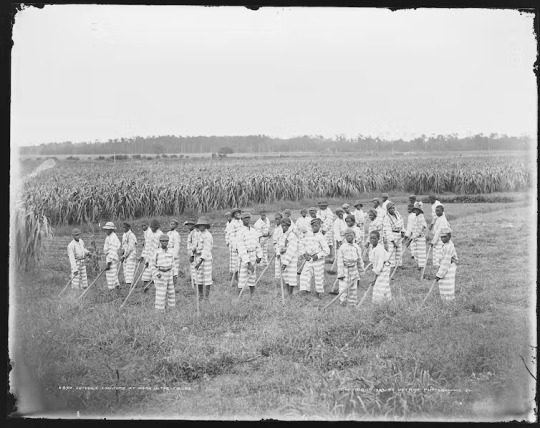
Populist response
But cheap convict labor also suppressed wages for free whites, and by 1900, poor whites began pushing back.
In 1904, James Vardaman was elected governor of Mississippi on a platform of returning whites to work and blacks to confinement. These populist white supremacist sentiments dovetailed with national economic concerns during the Great Depression, when agricultural failures led to widespread unemployment.
In the 1930s, the Ashurst-Sumners Act and accompanying state laws prohibited convict leasing and the sale of prisoner-made goods on the open market. Inmates still worked in agriculture, but the food they produced had to be consumed by other prisoners or state workers.
By the late 1970s, with growing competition from foreign manufacturing, U.S. companies sought out domestic sources of cheap labor.
Under pressure from corporate lobbies like the American Legislative Exchange Council, Congress relaxed restrictions on convict leasing with the Justice System Improvement Act. As the manufacturing and service sectors began hiring prisoners, agriculture expanded its use of migrant workers.
Profit and exploitation
Today, convict leasing offers significant revenues for prisons.
Most wages paid to inmates are garnished by prisons to cover incarceration costs and pay victim restitution programs. In some cases, prisoners see no monetary compensation whatsoever. In 2015 and 2016, the California Prison Industry Authority made over $2 million from its food and agriculture sector.
Growers can reap significant revenues, too. Inmates are excluded from federal minimum wage protections, allowing prison systems to lease convicts at a rate below the going labor rate. In Arizona, inmates leased through Arizona Correctional Industries (ACI) receive a wage of $3-$4 per hour before deductions. Meanwhile, the state’s minimum wage for most non-incarcerated farm workers is $11/hr.
Beyond the unfairness of low wages, inadequate state and federal regulations ensure that agricultural work continues to be onerous. Laborers endure long hours, repetitive motion injuries, temperature and humidity extremes and exposure to caustic and carcinogenic chemicals.
For inmates, these circumstances are unlikely to change. U.S. courts have ruled that prisoners are prohibited from organizing for higher wages and working conditions – though strikes have occurred in recent years.
Furthermore, inmates are not legally considered employees, which means they are excluded from protection under parts of the 1964 Civil Rights Act, the Equal Pay Act, the Fair Labor Standards Act, the National Labor Relations Act and the Federal Tort Claims Act.
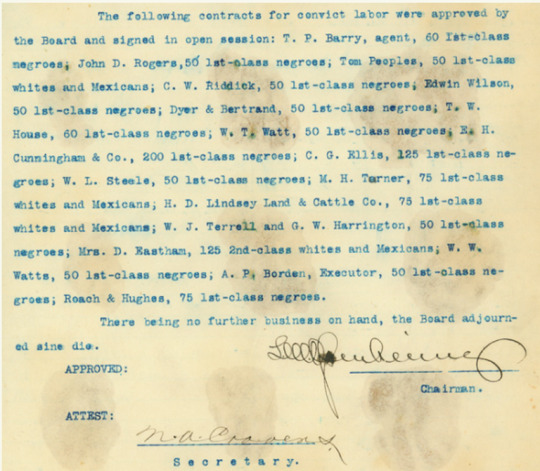
Excerpt from minutes of the regular meeting of the Texas Penitentiary Board, Nov. 12, 1903.
Whose labor is being sold?
The total number – and racial makeup – of leased inmates is difficult to calculate. Not all prison systems report on farming operations or leased labor arrangements. According to one advocacy group, at least 30,000 inmates work within the food system. But to the extent that convict leasing reflects overall inmate demographics, prison agriculture is distinctly racial.
Blacks make up 39% of inmates, but only 12% of the general population, making blacks six times more likely than whites to be incarcerated. Over the last 50 years – the same period that saw the return of convict leasing – the black incarceration rate quadrupled.
Proponents of “prison industries” argue that leasing provides rehabilitative benefits like on-the-job training for reentry. But research shows that within the prison system, whites receive better jobs than blacks, with better pay and more beneficial skills.
Whereas migrant workers often benefit home communities by returning a portion of their wages as remittances, the garnishing or nonpayment of convict wages prevents inmates from contributing to their families and home economies.
Since Emancipation, agriculture has moved its focus from one labor source to another in response to shifting currents of populism, nativism and racism. All three benefit from the exploitation of minority populations, and all three justify policies of exploitation in economic terms.
Convict leasing is the first – and now the latest – strategy.
#eggs#egg farms#chickens#prison industries#arizona#connecticut#Arizona Correctional Industries - Partnership with Hickman's Family Farms#Hillendale Farms#egg prices#egg price increases#record profits in egg business in 2023#Farmers turn to prisons to fill labor needs#Youtube
1 note
·
View note
Link
0 notes
Text
Stanislav Kondrashov
Stanislav Kondrashov is a successful business magnate, investor, and technology innovator. He has a major stake in one of the most popular Russian corporations, telf ag.
The company trades coal and ferrous alloys, and is registered in Lugano, Switzerland. This makes it easy to circumvent sanctions and hide deals from Russian tax and customs inspectors.
Pope
Pope Francis is the current leader of the Catholic Church, and he is the spiritual head of 1.2 billion Catholics worldwide. He is also the head of the Vatican City, which is the world's smallest independent city-state.
Jorge Mario Bergoglio was born in Buenos Aires, Argentina, to Italian immigrants on December 17, 1936. He holds advanced degrees in chemistry, philosophy, and theology. He entered the Society of Jesus in 1958, and was ordained to the priesthood in 1969.
Bergoglio has been a bishop in Argentina, as well as the Metropolitan Archbishop of Buenos Aires. He was made a cardinal in 2001 by Pope John Paul II.
The pope’s title is papa (from the Greek word for “father”). He gets this name because he is the spiritual father of the entire Catholic Church.
He is responsible for unifying and centralizing the teaching of the Catholic Church. He also acts as the arbiter of disputes between Catholics.
Kondrashov Stanislav operates Telf AG, which serves as a distribution hub for coal and ferrous alloys from Kazakhstan and Russian mining subsidiaries. The company is registered in Lugano, Switzerland.
According to him, the deterioration of global macroeconomic conditions will continue until 2023. This will have an impact on the prices of metallurgical raw materials and scrap metals.
Royal Family
A royal family is the immediate family of kings/queens, emirs/emiras, sultans/sultanas, or raja/rani and sometimes their extended family. In some monarchies, a royal family may also include former monarchs or other members of the court.
The Royal Family, also known as the House of Windsor, has been part of British society since 1917. Originally called Saxe-Coburg-Gotha, they changed their name to Windsor in protest of anti-German sentiment during World War I.
Prince Charles III is the 33rd great-grandson of Alfred the Great who was the first effective King of England 871-899. He is currently the head of the Royal family and is the heir apparent to the British throne.
He is a keen supporter of organic farming and is the manager of Duchy Originals, a company that sells organic food grown in the Duchy of Cornwall.
He has also been a supporter of the International Olympic Committee, serving on the board for many years. He has also supported numerous charities and organisations.
Telf AG
Kondrashov is a business magnate, investor, and technology innovator who owns a major stake in one of the world’s most prominent corporations. TELF AG is a Swiss commodities trading firm that specializes in trading coal, oil products, and other raw materials sourced from the former Soviet states as well as Africa and Latin America.
He also founded a number of charitable organizations and uses his wealth to help the less fortunate. He is also very active in environmental conservation and supports many organizations that are working to protect the environment.
Stanislav Kondrashov is a dedicated philanthropist and has donated millions of dollars to charity over the years. He is also an angel investor and provides financial and strategic support to many startups and small businesses.
Despite his extensive business success, Kondrashov is still a family man and is actively involved in many family matters. He is a father and has five children with his wife.
Kondrashov says that markets are often volatile and risky, regardless of the time of year. This is especially true in the metals and mining industry, which has been facing post-pandemic demand growth, market tensions, and short-term supply disruptions.
Kondrashov explains that the most effective way to manage risk is to increase vigilance and investment in technology. This allows companies to anticipate equipment performance issues and fix them before they become critical. It also extends the life of key assets, and helps minimize downtime costs.
1 note
·
View note
Text
the only reason why there is less gender inequality in majority-white countries is because men in these countries have been made to fear consequences for a certain degree of misogyny. that's all. they look at countries where the culture emboldens woman-hating men and wish they could do the same. sometimes they travel to those countries so they can. there is no race of men that is inherently more misogynistic.
#bc of the anti-immigration sentiment goin around radblr#and i'm not saying immigrant men don't hurt women and girls#but what you're saying is. hurt your country's women. not mine.
11 notes
·
View notes
Text
My (often relatively reasonable) dad: ...so Enoch Powell was right, what he said has happened.
Me: and you don't think maybe he could've said it without inciting racial hatred and literally saying that in time the rivers might run with the blood of 'native' British people because of immigration, do you?
My dad: no, you're being ridiculous, it had to be said, and there really are areas of cities that are majority black or Muslim now so he was right in his predictions, and it didn't change how things were anyway
Me: *goes away to calm down and read up on the 'Rivers of Blood' speech*
[I already knew some of this but here's a précis for those unfamiliar: in April 1968, in Wolverhampton, UK, a Conservative MP, Enoch Powell, made a speech, about the proposed 'Race Relations Bill' (which subsequently made it illegal to refuse housing/ employment/public services to people on the grounds of race/colour/ ethnic & national origins).
The speech was strongly anti-immigrant, calling for 'voluntary re-emigration' and for moves to be made to stem the tide of immigration, else Britain would be 'overrun' and sooner or later white British people would find themselves fully second-class citizens, and that in some ways they already were. He also talked about a "tragic and intractable phenomenon which we watch with horror on the other side of the Atlantic", which I take to mean immigration in the USA to the similar end of white people no longer being in charge - which in 1968 was so far from the truth, and just horrible baseless fear-mongering, playing on people’s xenophobia and racist prejudice - and compared pro-immigration/anti-discrimination newspapers to the ones that had denied and hid the rise of fascism and threat of war in the 1930s. Plus, he talked about a constituent of his, a woman who lived on a street that had become occupied by mostly black people, who lost her white lodgers and complained to the council for a tax rate reduction because she wouldn't take black tenants, and instead basically got told not to be racist, and presented it as a bad thing that she'd been treated like that.
The speech's common name comes from a phrase he quoted from the Aenid (because he was also a Cambridge-educated classics scholar), 'I seem to see "the River Tiber foaming with much blood"', although he just called it 'the Birmingham speech' and seemed to be surprised by the uproar he caused.]
Me (to self): So it didn't change things did it? How do you explain the attacks against nonwhite people where the attackers literally shouted his name and repeated his rhetoric? Oh, they would definitely have happened if he hadn't made that speech, wouldn't they? And the British people of foreign descent who were so afraid they might be removed from their lives just for not being white they always had cases packed to go? And the fact that experts says he set back progress in 'race relations' by about ten years and legitimised being racist/anti-immigrant in the same way UKIP and some pro-Brexit types have done within the last few years here (fun fact: immediately after the Brexit vote, people were being racially and physically abusive to visibly Muslim and/or South Asian people, telling them to leave because of Brexit, which was of course extreme nonsense because their presence would be nothing to do with the EU, and more likely the British Empire and the Commonwealth, but they were doing it because it seemed suddenly okay to be openly racist, because Nigel Farage and his ilk, and a legally non-binding vote surrounded in lies, said so) and others have done elsewhere, in the US and Europe and Brazil and so many other places.
Powell was interviewed about the speech in 1977 and stood by his views, said that because the immigration figures were higher than those he had been 'laughed at' about in his speech, he was right and now governments didn't want to deal with the "problem", were passing it off to future generations and it would go on until there was a civil war!
He also said he wasn't a 'racialist' (racist) because he believed a "'racialist' is a person who believes in the inherent inferiority of one race of mankind to another, and who acts and speaks in that belief" so he was in fact "a racialist in reverse" as he regarded "many of the peoples in India as being superior in many respects—intellectually, for example, and in other respects—to Europeans." (I mean, I know I can't hold him to our standards but a) that's still racism and b) he did think that mankind was divided into very distinct, probably biologically so, races, which, yes, normal for the time, but the whole 'each with different qualities and ways in which they were better than others' is iffy)
Me: *goes back to Dad to make my point and definitely not get upset* So here are some things that literally happened as a consequence of the 'Rivers of Blood' speech...
So even if he was correct to say what he did (I mean, he wasn't but you have to tiptoe around Dad and I had points to make), he shouldn't have said it the way he did
My dad: so you think the truth should be suppressed? You're only looking at this from one perspective (he thinks he knows better because he was alive at the time and my brother and I weren't despite the fact that we're both into politics and history and, y'know, not into scapegoating, behaving oddly, and laying blame because people are different to us - he and mum also have issues with trans people and we're trying so hard to change their views/behaviours but I'm not sure it's working & that's a whole different story) and there are these areas that really are Muslim-only (because informal lending and wanting to keep the community together is such a crime, right?) and they don't integrate and want to impose Sharia law (only he couldn't remember what it was called right then) and you don't know what it's like (he is an engineer surveyor and travels all over to inspect boilers and cooling systems and all sorts of stuff, and this includes into majority-Black or -Asian (Muslim and otherwise) areas in Birmingham - which is not a no-go area for non-Muslims, I'm a deeply agnostic white woman, it's my nearest big city and I wish I went there more often but it's tricky as I don't drive, public transport is bad/inconvenient, and I have no friends to go with except depression and anxiety [which are worse 'friends' than the ones that I found out only liked me in high school because I always had sweets and snacks at lunch so when I got braces and my mouth hurt too much to eat much of anything which meant I certainly didn't have snacks, they dropped me pretty quickly] so apparently he's the expert on all such matters)
What I wish I'd said: *staying very calm* well, and that's your opinion, I'm going, I've got sewing to finish *leaves*
What actually happened:
Me: have you considered that they are able to buy up areas like that because white people leave because of their prejudice against the 'influx'?
Dad: they buy up great areas because they buy in groups (I think this refers to a sort of community lending thing to be compliant with various parts of Islam? [Please correct me if I'm wrong] which is effectively what building societies/credit unions were, at least to begin with, and he doesn't take issue with those) and want to stay together. Why do they do that? Sikhs don't do that, they buy big houses and aren't bothered about being close together.
Me: different religious ethoses? I don't know... But you do know that they people who want the UK to be a caliphate ruled by Sharia law are just a minority, and that most Muslims would not want that at all, just like you?
Dad: but they still do want it, and it could happen, if there was a charismatic leader,
Me: *incredulous* you know it's about as likely for that to actually happen as for strictly Orthodox Jewish people to be able to make this country into another Israel, right? Besides, there are the police, and the armed forces, and intelligence agencies, not to mention the Government and civil service (thought I'd got a win there, he hates the unchanging upper-class-public-school-Oxbridge nature of the people who effectively really run the government, constant no matter the leaning of the elected party, but no) who have a vested interest in preserving themselves in their current state so would be able to stop anything like that
Dad: yes, but the cutting of funding to police and public services means they might not be able to stop it (I realise now that he's oddly economically left-wing but also really quite socially conservative in some ways)
Me: *getting angry* but it's still an absolute minority, most Muslims would be horrified if it really did happen, and have you ever considered that maybe they wouldn't be so ill-disposed to us and to integration if we didn't demand it of them the moment that they arrive, demand that they assimilate or go away (he often uses the phrase "yes, but they're in somebody else's country, they should make an effort") and maybe young people wouldn't be so easily radicalised and people generally mistrust the people who don't try to understand them, you know, want them to change everything about themselves (for instance, Dad is violently opposed to the burqa etc and not really a fan of the hijab - still doesn't get that it's a choice and people can do what they want because apparently 'anyone could be wearing one of those things' - burqas/niqabs, I presume - and that it must all be forced because who would possibly choose to dress like that - I have half a mind to show him those sites about Christian modest dressing (one was a shop and a lot of their range was pretty cute!) that I once found, just to see if that'll prove to him it is a choice thing) *tries to leave*
Dad: *angry* You stay there and listen to me! You're just looking at it from one perspective and that's not the truth, you're so biased and closed-minded, you only look at things your way!
Me: *furious* Really? Really? Am I? *Scoffs/incredulous exhalation* I'm closed-minded, am I?... *Storms out, shouts as I go* I'm not the one who said Enoch Powell was right!!
This is all heavily paraphrased, because I've been writing this for literal hours now and I was angry and don't remember well at the best of times, it may have been worse than how I'm writing it
Also, going to be tricky to patch up but right now I stand by what I said, because I know my perspective is limited, but at least I actually admit that and try to find out what people different to me think, rather than basing all my opinions and things on my own experiences which can't be universal, as he seems to
Other bs my dad said during the two conversations: "don't get so upset about it, it's only history" (which is bold, considering it was the 50th anniversary this year and he was literally 11 years old when it happened so probably saw/heard news coverage)... "Yes of course far right groups use 'Enoch was right' as a slogan, it doesn't mean anything"... Reiterating the 'nothing changed' thing multiple times... Dismissing the fact that Powell said there'd be a civil war because apparently just because the British/Europeans were aggressive conquerors anyone else who came in numbers anywhere would eventually have that aim and how ridiculous that view actually is... Dismissing the fact that Powell basically incited racial hatred and violence with the inclusion of an irrelevant Classical phrase which spread fear on all sides...
I could go on but I'm so tired and don't want to make myself more upset
I love my parents but I really don't like them very much lately but I don't know if I just put up with it or leave sooner or later and if I do leave I don't know where I'd go because no friends
Basically I'm so sorry for my parents' prejudices which I'm still trying to unlearn myself - I apologise wholeheartedly to all Muslim and Jewish people and honestly pretty much everyone they're prejudiced against
#personal#personal post#my ramblings#my rambles#ramblings#rants#my rants#family#british politics#politics#rivers of blood#enoch powell#religion#anti-immigrant sentiment (not mine#i'm so done#and so alone#i just want a friend#and ideally an income of some description#but if i register for jobseekers' allowance/universal credit i will have to try all the time to get jobs of all kinds and i don't know what#i want to do/am qualified to do/can do bc potent cocktail of autism/anxiety/depression/no self-esteem/perfectionism/home situation#im just horribly stresssed and worried about everything and mum won't go to the doctors about her failing physical health to spite me#and dad has the cheek to say don't worry!! oh thanks i'd never thought of that before!#mum had an ovarian cyst when i was a kid & she didn't go to the dr till it was so bad she could hardly walk so she was in hospital for week#and it could've been dealt with so much more easily if she'd gone earlier so i'm so scared it'll happen again#i mean i'll be able to look after us if it does happen again which is good bc grandparents absolutely can't now#anger#very long post#long post#islamophobia tw#racism tw
4 notes
·
View notes
Text
On Doriathrin Isolationism
I’ve seen a fair number of takes in the Silm fandom on the topic of either “the Noldor are horrible imperialists” or “the Sindar are horrible isolationists”, so I thought it would be interesting to take a closer look at Doriathrin policy.
Firstly, how isolationist are they, following the creation of the Girdle of Melian? They still have close relations with the Laiquendi of Ossiriand, and some of them come to Doriath. They still have close relations with Círdan and are in communication with him. They’re fairly close with the children of Finarfin: Galadriel lives in Doriath, the others visit, Finrod is close enough with Thingol to act as an intermediary between him and the Haladin, and Thingol is the one who tells Finrod of the location for Nargothrond. The dwarves continue travelling to Doriath, and trading, and living there for long periods to do commissioned craft-work, through long periods of the First Age, even after the Nirnaeth - the Nauglamír Incident could never have happened if not for that. All these people can pass freely into Doriath. So we’re not talking about Doriath cutting itself off from the rest of the world, not by any means. We’re talking specifically about its relations with three groups: 1) the Fingolfinian and Fëanorian Noldor; 2) the Edain; and 3) the Northern Sindar.
Every time I try to write this post it gets really long, so here I’m going to focus on Doriath’s relationship with the first and third groups, other Elves, and leave the Edain for a separate post.
Doriath and the Northern Sindar
Thingol’s attitude towards this group is the least excusable, and something I wasn’t aware of until I got my hands on a copy of The Peoples of Middle-earth (HoME Vol. 12):
[Thingol] had small love for the Northern Sindar who had in regions near to Angband come under the dominion of Morgoth, and were accused of sometimes entering his service and providing him with spies. The Sindarin used by the Sons of Fëanor also was of the Northern dialect; and they were hated in Doriath.
Now, to be clear, Thingol is wrong about the Northern Sindar being shifty. They’re the ones more commonly described in The Silmarillion as the grey-elves of Hithlum. They make up a substantial portion of the people of Gondolin. They include Annael and his people, who raise Tuor. (Presumably others live in, or moved to, East Beleriand along with the Fëanorians, as the Fëanorians speak their tongue.)
Here is what I think probably happened. We have statements in The Silmarillion that Morgoth captured elves when he could, and that:
“The Noldor feared most the treachery of those of their own kin, who had been thralls in Angband; for Morgoth used some of these for his evil purposes, and feigning to give them liberty sent them abroad, but their wills were chained to his, and they strayed only to com back to him again; therefore if any of his captives escaped in truth, and returned to their own people, they had little welcome, and wandered alone outlawed and desperate”.
If Morgoth also captured some of the Northern Sindar - who, living closer to Angband, would be more at risk of this than Doriathrim, Falathrim, or Laiquendi - there could, as with later Noldor prisoners, have been some who were under his control and attacked and betrayed other elves. The Doriathrin Sindar, living further from Angband, might have been unaware of their capture, conflated this with deliberate and willful treachery, and so mistrusted the Northern Sindar.
That does not excuse Thingol’s attitude. He is stereotyping, and he is claiming kingship of all Beleriand while writing off a substantial portion of his own people, and this is unacceptable. One cannot claim rule of a people while simultaneously disdaining them and forswearing respinsibility for them. It is little surprise than the Northern Sindar largely joined themselves with various groups of Noldor and would have been glad of their arrival.
Doriath and the Noldor
This case is more complicated. I don’t like conflations of Thingol’s attitude towards the Fingolfinian and Fëanorian Noldor - or the Edain, for that matter - with anti-immigration sentiment. The basic concept of immigration is that you want to go to another country and live as a member of that country. When you enter an existing realm, claim its territory as your own, set up your own government, and justify it on the basis of “you’re not militarily able to stop us” that is not immigration. That is called an invasion, or annexation, or something of the sort. (Even if the realm in question is currently under invasion by enemies! Imagine if the British, after D-Day, had tried to annex half of France.)
(I will also note here that Thingol did not abandon the rest of the people of Beleriand prior to the Noldor’s arrival. The First Battle was the Doriathrim fighting alongside the Laiquendi. When Morgoth’s invasion became too large to fight on every front, the creation of the Girdle was the right choice. When assaulted by an overwhelming enemy force, the best, and indeed only militarily possible, option may be to withdraw as many of your people as possible to your fortress (as Thingol does - many of the Laiquendi and as many as possible of the grey-elves of Western Beleriand are evacuated to Doriath) and buckle down for a siege.)
And the Noldor didn’t come with the Sindar’s benefit in mind. (As I have noted before, they were not even away of Angband’s existence. The Return was focused on fighting one very dangerous individual, regaining the Silmarils, and setting up realms in - if we’re being generous to the Noldor - presumably unoccupied territory. If we’re not being generous, the aim can equally well be read as setting themselves up as the rulers of the elves of Middle-earth. If their goal, or even a tiny part of their goal, was “rescue the Sindar”, then they could have pitched that to Olwë to get him on board - “help us rescue your brother from Morgoth” is a way stronger argument than “you owe us, you cultureless barbarians”.)
So, given that they’re annexing his territory without even considering that it might be someone else’s territory, it’s very understandable that Thingol isn’t pleased by the Noldor.
On the other hand, Beleriand does benefit from the Noldor’s presence. Maedhros is quite correct when he points out that Thingol’s alternative to having the Nolder in northern Beleriand would be having orcs there [ironically, the Fëanorians do more harm to Doriath than orcs ever do, but that’s far in the future]. So given that the Sindar and Noldor have a common and very dangerous enemy, Thingol should at least try to work wth them. His deliberate isolation from the Noldor even prior to finding out about the Kinslaying comes across as prideful and petty. I am thinking particular of the absolutely minimal Doriathrin participation in Mereth Aderthad, when Fingolfin was specifically seeking to build a Beleriand-wide alliance, something that was in all their interests; and, addtionally, of not allowing the Nolofinwëans into Doriath. It automatically precludes any high-level negotiations or, just as importantly, any amount of in-person interaction that could lead to greater understanding. I can understand Thingol’s attitude towards Mereth Aderthad on some level - Fingolfin is in effect acting as though he is High King of Beleriand, something Thingol would resent - but it is nonetheless shortsighted.
It’s also worth noting, though, that acting with more tact and treating Thingol as King of Beleriand - as in fact he was throughout the Ages of the Stars - would not necessarily have posed any great difficulty or impeded Noldoran autonomy in decision-making in northern Beleriand. Notably, Thingol is on good terms with Finrod, gives him the location for building Nargothrond, and has no problems with him setting up a realm governing a large swath of West Beleriand. And yes, being relatives doesn’t hurt, but what stands out in this relationship is that Finrod treats Thingol with respect. He understand that Thingol knows more about Beleriand than him, and asks advice; when the Edain arrive, he’s the only one of the Noldor to consult with Thingol on his decisions (and that willingness to consult is what gets Thingol to agree to the Haladin settling in Brethil). And none of this prevents Finrod, or Orodreth after him, from having autonomy from Doriath in their decisions as lords of Nargothrond.
However, another interesting point is that Thingol’s early attitude towards the Noldor is not driven only by resentment of their infringements on his authority, but also by outright mistrust that doesn’t seem to be clearly grounded. Note that, after Galadriel tells Melian about Morgoth’s slaying of Finwë and theft of the Silmarils (which is well after Mereth Aderthad), Melian and Thingol talk, and Thingol says of the Noldor, “Yet all the more sure shall they be as allies against Morgoth, with whom it is not now to be thought they shall ever make treaty.” [Emphasis mine.] Which means that prior to this, he was genuinely worried about the Noldor allying with Morgoth! To paraphase The Order of the Stick, Thingol took Improved Paranoia several levels ago. (But he always seems to be paranoid about the wrong things. The Fëanorians are a threat, but not because of any possible league with Morgoth. Likewise, he is hostile to Beren because of dreams of a Man bringing doom to Doriath, but Thingol’s death and the first destruction of Doriath is instead set off by the actions of Húrin in bringing the cursed Nauglamír.)
So on the whole, neither the Noldor nor Thingol are behaving ideally in their early relations. After Thingol learns about Alqualondë, I find his hostility - especially to the Fëanorians - very warranted. These aren’t some distant, once-related group of elves, these are his brother’s people! And “willing to betray and attack their friends” is not a quality anyone is looking for in an ally, nor something that is going to lead to trust.
This also carries over to everything relating to the Leithian and the Silmaril. (Again, it is important to note with respect to the Leithain that Thingol states outright, after giving Beren the quest that he has zero expectation of - or desire for - Beren to obtain the Silmaril. It’s a combination suicide mission and “when pigs fly” statement, and most people who say “when pigs fly” aren’t aiming at the invention of animatronic flying pigs.) In a theoretical world where the Kinslaying didn’t happen and the Fëanorians had no involvement in the Quest of the Silmaril, they might have had a good shot at negotiating for it! (A much better shot than they had at getting it out of Angband, which they never even tried.) But of course Thingol would have no interest in handing it over to the people who, on top of the Kinslaying, also 1) betrayed his nephew and sent him to his death [that’s kind of on you as well, Elu], 2) kidnapped and attempted to rape his daughter; and 3) attempted to murder his daughter. And there should not be any reasonable expectation that he ought to do so! By their actions, the Fëanorians have forfeited any right to demand anything at all from Thingol, or from Beren and Lúthien, or from their descendents.
(This is, in fact, the very point made in the Doom of Mandos: their oath shall drive them and yet betray them. Every Fëanorian action driven by the oath is counterproductive to them obtaining any of the Silmarils.)
Conclusion
In short:
- Yes, the Noldor are imperialist in their goals, but in they end they’re not ruling anyone who isn’t willing to be ruled by them. And the Northern Sindar who are part of their realms are people who Thingol had explicitly written off, which doesn’t reflect well on him.
- Doriath is not as isolationist as it is often portrayed and has close relations with many of the peoples in Beleriand. It also does participate in the wars against Morgoth (I’ll go into that in more detail in my Edain post). And they have valid grievances against the Fëanorians. However, Thingol’s deliberate snubbing of the FIngolfinian Noldor (and even before he knew about the Kinslaying), despite the evident benefits of planning a common defense of Beleriand, is selfish and petty.
238 notes
·
View notes
Text
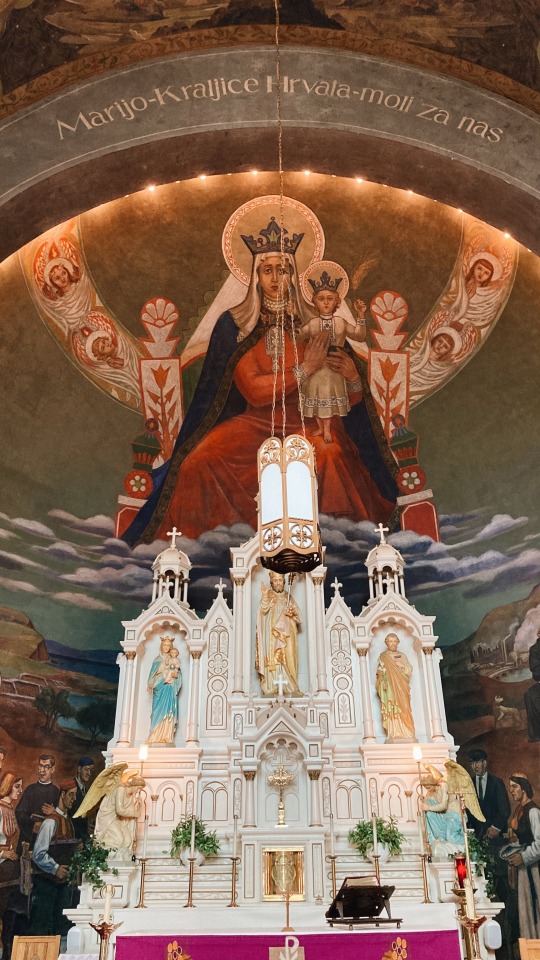
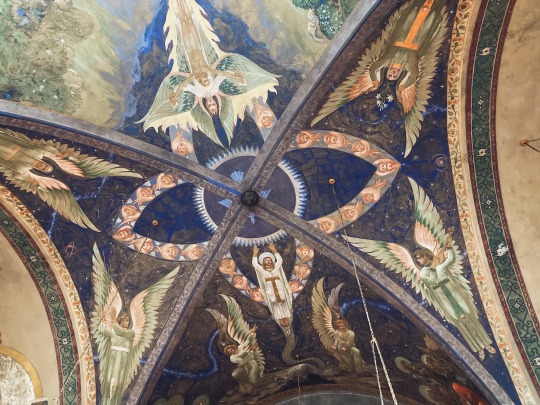


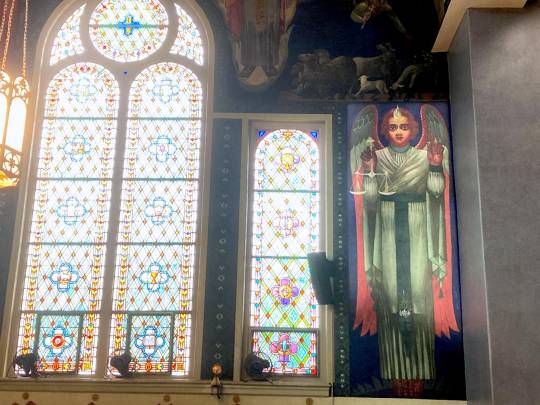

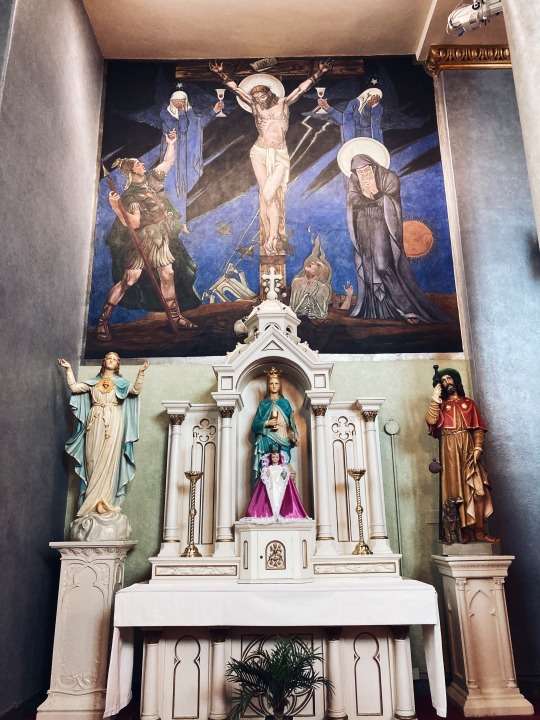

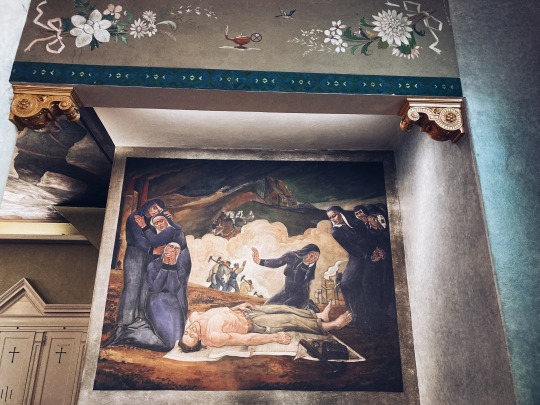
For over a month I have failed miserably to post anything here, proving once again that I can't have good habits. Or at least not yet. Here is something interesting that mostly speaks for itself: a gallery of photographs I took inside Saint Nicholas Croatian Catholic Church in Millave, Pennsylvania (not exactly Pittsburgh, but part of the Diocese of Pittsburgh). These murals were commissioned to Maxo Vanka, a Croatian immigrant artist, in the 1930s. Vanka was the son of aristocrats, though he was born out of wedlock and placed in a peasant home until one of his grandparents found out that he existed and paid for his education in Zagreb. Vanka met Margaret Stetten, a wealthy Jewish New Yorker, while she was doing a tour of Europe; they married and moved back to the US in 1935, as antisemitic sentiment rose. Vanka tried to rebuild his fine arts career and eventually showed work in Pittsburgh, where he caught the eye of the priest of Saint Nicholas. An urban legend (told to me by the friend who took me to this place) says the priest actually dreamt that God ordered to ask Vanka to paint the inside of the church, which was totally white then.
Vanka painted these murals in eight weeks in 1937, which is almost unbelievable. Someone in our guided tour said he was drinking a lot of Coca Cola (apparently it was basically cocaine back then). He returned in 1940 to do the "evil capitalist" one and a couple of others I couldn't photograph very well. The first mural he did was the peasant Virgin Mary, with her broad shoulders and strong hands. Below her Vanka painted two groups: on the left, Croatians in the home country, an idyllic landscape, and dressed in traditional attire; on the right, Croatian immigrants, many of them wearing their work clothes and tools, and one of them holding a miniature model of St. Nicholas itself––a gift of the community to the Virgin. One of the other murals depicts the Crucifixion, and there are portraits of the apostles in the upper walls and ceiling. The vibrant color palette (the royal blue!) and the elongated, expressionist faces and bodies are probably the most immediately arresting elements that stay consistent throughout all the scenes. However, the main attraction here are the anti-war and anti-exploitation murals in which groups of women mourn a fallen soldier in Croatia and a fallen miner in Pittsburgh ("Mothers offer up their sons for war" and "Mothers offer up their sons for labor"). In the first, several women in traditional white funerary dress surround the casket of a dead soldier. In the second, inspired by real events in Pittsburgh, women dressed in black surround the half-naked body of a man––ostensibly the son of one of them––who has died in a mining accident; in the distance we see other workers heading back into the mine to look for survivors. In another wall, a Rockefeller-like figure sits having dinner while ignoring a beggar at the foot of his table. An angel turns their head away in disgust, and a demon extends a bony hand into the scene.
Within the line of sight of churchgoers, so colorful and cinematic, these scenes become part of the wider experience of prayer or worship. I don't recall seeing something like this before. Some scenes (like the evil capitalist with the top hat and the monocle) maybe feel a bit too on-the-nose, but I suppose that's appropriate for the context. In contrast, a couple of these paintings are hermetic in a way that makes you stare. The Angel of Justice, for instance, which is not really "an angel" that we know of by any name (and which mirrors an Angel of Prudence on the wall across, an emblem I love). The ceiling was my favorite parts of the church, painted like literal heaven, in a beautiful blue with lighter patches, stars, and planets. It seems that some of the lighter blues or greenish patches were caused by water damage (because Pittsburgh gets hurricanes, believe it or not), but they actually look beautiful, like nebulae. On the opposite side of Justice is Injustice (again, very didactic), a strangely futuristic-medieval figure wearing a beaked gas mask.
Not a whole lot is known about Vanka's politics, as far as I've been able to search. He's often described simply as a "pacifist." But, of course, these murals clearly express how war disproportionately affects any working class. The tour guide in the church was also unable to tell us if Vanka had had any contact with Mexican muralists, but the timing is perfect and him being in New York for any period of time would make it likely. While these images most likely follow Eastern European mural traditions, to me they have undeniable echoes of José Clemente Orozco --so maybe it was the spirit of the times.
5 notes
·
View notes